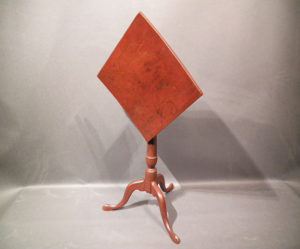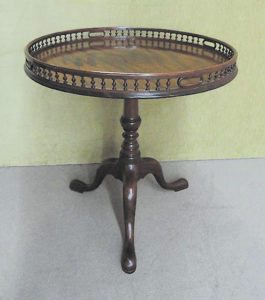 By Anne Gilbert
By Anne Gilbert Antique candlestands served many different functions. Not every small 3-legged tripod table is a candlestand. In fact, not every candlestand rests on a tripod. And, what about the candlestands that have more than one tier? Actually a simple check and balance system can determine the purposed of a tripod table. Just try putting a heavy kettle, lamp or tray of food on what seems to be a candlestand. When put off balance it will of course, tip. It was only made to hold a candlestick. Since balance was important early 18th century candlestands had a base that touched smoothly on the floor. The tripod base had a serious purpose. It lessened the chance of tipping on the uneven floors of that period.
A wine table can be recognized by its small protective gallery of brass or wood(railing.) A dumbwaiter table held sweets and other tidbits on two or more tiers. Tall tripod tables (36” and up ), called “torchyeres” held candles. When taller they were made to hold plant urns. The most most elegant examples are Chippendale style. Some had tilt-tops, piecrust or “birdcage” styling at the top of their column. Often the central column was carved and beautifully turned. Cabriole legs ended with claw and ball feet. Tops varied from round, oval and octagonal to square.
CLUES; Candlestands made during the Federal Period (1788-1825) in the George Hepplewhite style, can be recognized by tripods ending in slipper, snake or spade feet. Woods depended on the locale where they were made. Mahogany, cherry, pine and walnut. During this period they were also painted in back, other colors and ivory.
Pieces made in the Sheraton (Federal) period had concave tripod legs with carved fluting often decorating the central column.
By the 1830s tripod tables had lost their charm. One reason being that factory production was replacing the individual craftsman. Bases were heavy and the tenon joints were glued rather than nailed. By the mid 19th century they were replaced by various plant and lamp tables in Rocco and other revival styles. Afterall, who was using candles when they could have a fancy oil lamp?
 In the 1920s both country and high style candlestands were reproduced,
In the 1920s both country and high style candlestands were reproduced, When buying a supposedly 18th century table turn it upside down and look at the construction. It should be rough to the touch. Sawmarks will tell you if it was made after 1880 or in the 20th century. Look for old rosehead nails.
Even though brown antique furniture is currently down in popularity check what’s going on at auctions around the country. A good time to buy as an accent piece.
PHOTO CAPTION :(1) Federal tilt top table. PHOTO CREDIT: greg@gregkramerandco.com PHOTO CAPTION; (2) Tripod wine table PHOTO CREDIT: Hyde Park Antiques, New York















Follow Us